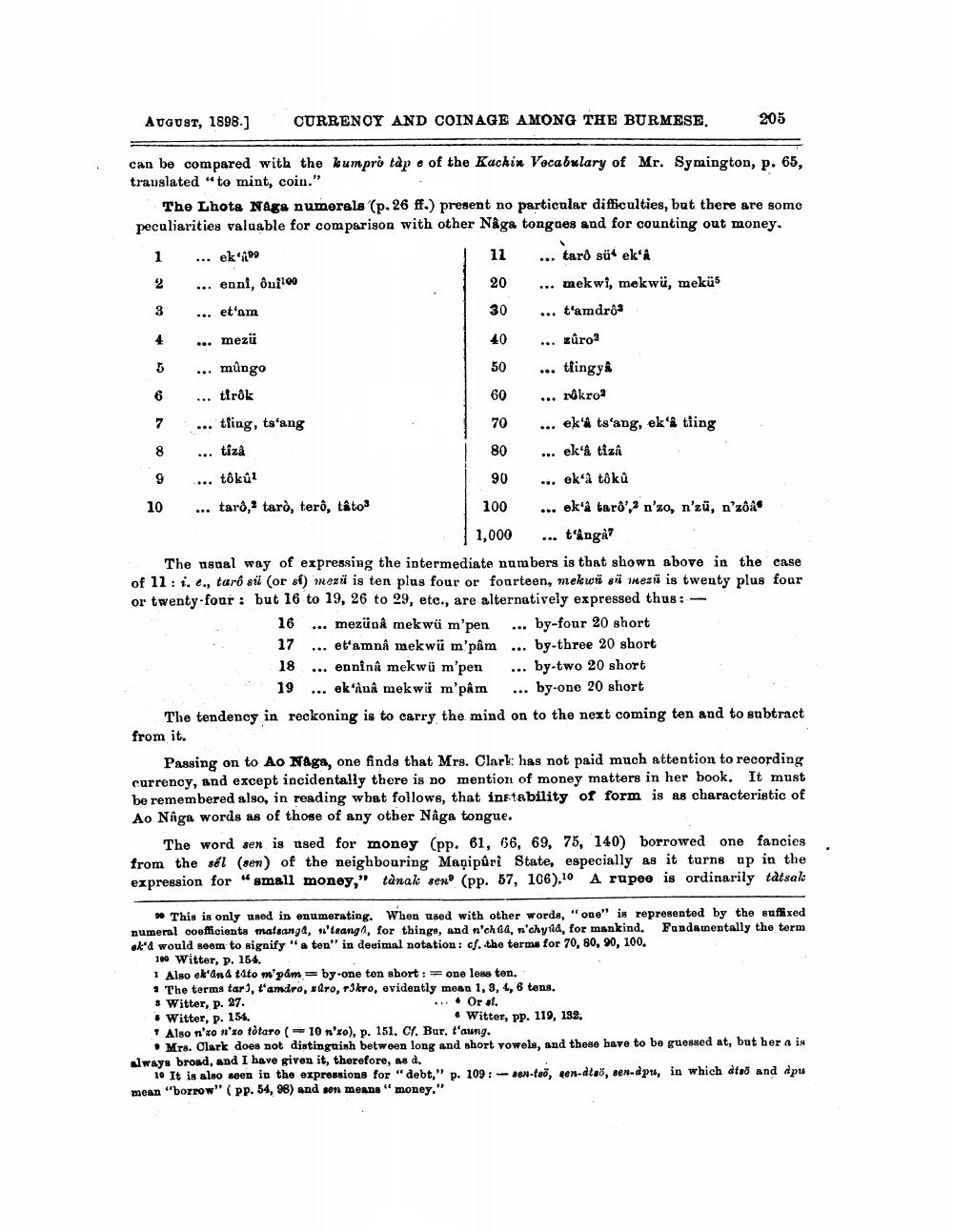________________
AUGUST, 1898.]
can be compared with the kumprò tape of the Kachin Vocabulary of Mr. Symington, p. 65, translated "to mint, coin."
1
2
3
The Lhota Naga numerals (p. 26 ff.) present no particular difficulties, but there are some peculiarities valuable for comparison with other Någa tongues and for counting out money.
11
tard sü' ek'â
20
... mekwi, mekwü, meküs
30
... t'amdrô
... zûro3
4
5
6
7
8
9
CURRENCY AND COINAGE AMONG THE BURMESE.
10
... ek'
... enni, ôni100
... et'am
... mezü
... mûngo
tirok
... tfing, ts'ang
tizâ
tôkúl
tarô, tarò, terô, tâto
...
-...
... ek'a ts'ang, ek'a tling
ek'å tizâ
ek'à tôkû
ek'a taro', n'zo, n'zü, n'zôâ
tingi
The usual way of expressing the intermediate numbers is that shown above in the case of 11 i. e., tarô sü (or si) mezü is ten plus four or fourteen, mekwü si mezi is twenty plus four or twenty-four: but 16 to 19, 26 to 29, etc., are alternatively expressed thus:
16. mezünâ mekwü m'pen 17... et'amnâ mekwü m'pâm 18 enninâ mekwü m'pen
19. ek'ânâ mekwi m'pâm
...
40
50
60
70
80
90
100
1,000
...
...
1 Also ek'and tato m'pâm by-one ten short: The terms tar), t'amdro, zûro, r3kro, evidently 8. Witter, p. 27.
Witter, p. 154.
...
...
=
...
tlingy &
rôkroa
...
... by-four 20 short ... by-three 20 short by-two 20 short
by-one 20 short
205
The tendency in reckoning is to carry the mind on to the next coming ten and to subtract from it.
Passing on to Ao Naga, one finds that Mrs. Clark has not paid much attention to recording currency, and except incidentally there is no mention of money matters in her book. It must be remembered also, in reading what follows, that instability of form is as characteristic of Ao Naga words as of those of any other Någa tongue.
The word sen is used for money (pp. 61, 66, 69, 75, 140) borrowed one fancies from the sél (sen) of the neighbouring Manipuri State, especially as it turns up in the expression for "small money," tanak sen (pp. 57, 106).10 A rupee is ordinarily tatsak
This is only used in enumerating. When used with other words, "one" is represented by the suffixed numeral coefficients matsanga, n'teang, for things, and n'chia, n'chyúld, for mankind. Fundamentally the term ek'd would seem to signify "a ten" in decimal notation: cf. the terms for 70, 80, 90, 100.
100 Witter, p. 154.
one less ten.
mean 1, 3, 4, 6 tens.
• Orat.
Witter, pp. 119, 132.
Also n'xo n'zo tòtaro ( 10 n'xo), p. 151. Cf. Bur, t'aung.
Mrs. Clark does not distinguish between long and short vowels, and these have to be guessed at, but her a is always broad, and I have given it, therefore, as d.
10 It is also seen in the expressions for "debt," p. 109: sen-tao, en-dteo, sen-àpu, in which dtso and apu mean "borrow" (pp. 54, 98) and sen means "money."




